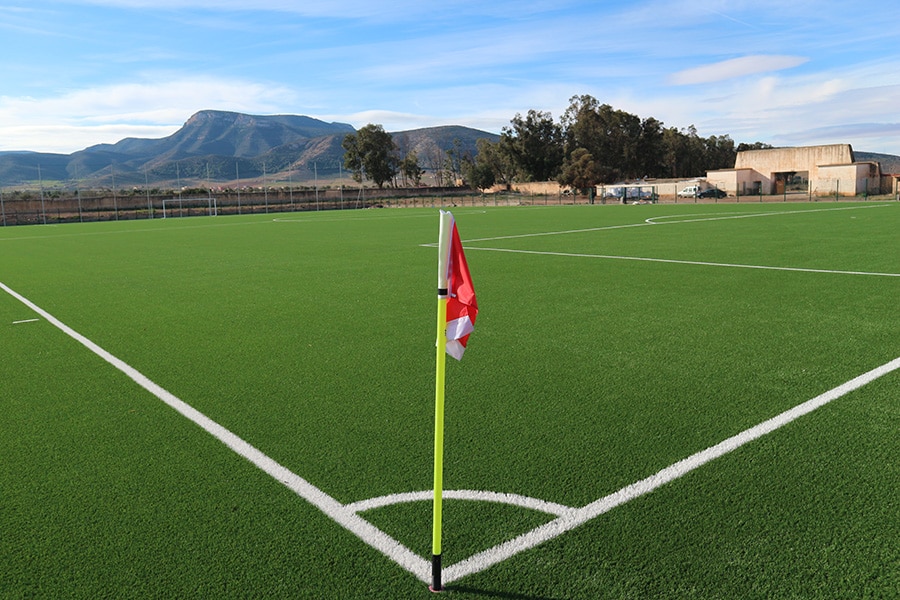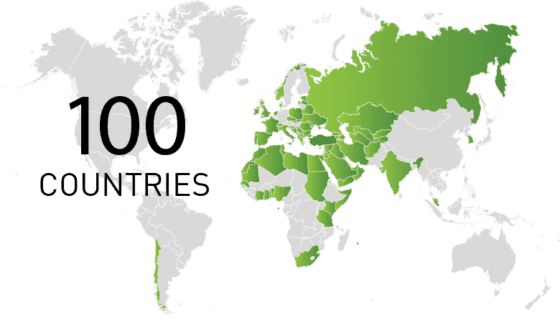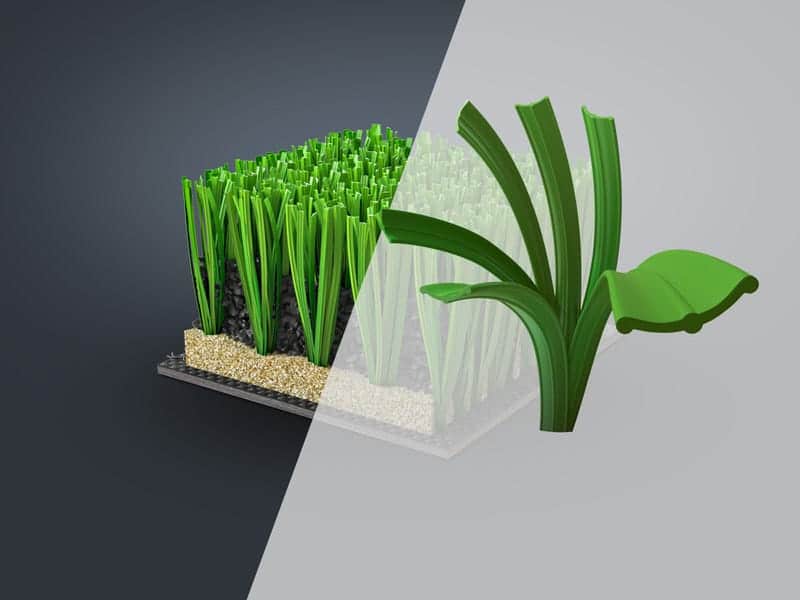


The manufacturing area of Hatko established on 25.000 square meters surfaces and we are using the latest technology on the production. The yearly production capacity of Hatko is 6.000.000 square meters. And all of our orders fastly delivered on time.
Our newest products are Hybrid grass, Omega Turf XL and Trophy Non-Filled Artificial Turf. These products show the strength of Hatko’s innovation.
Our Hybridgrass and Omega Turf XL products have been chosen by Premiere Football Clubs of their countries such as RKC (Netherlands), FC COPENHAGEN (Denmark), FC Nordjealand and FC ZENIT (Russia).
Hatko got awards in 2017 and 2018 from the Ministry of Industry for innovative product development strategy’s success.
Artificial grass is a surface manufactured from synthetic fibers made to look like natural grass. It is most often used in arenas for sports that were originally or are normally played on grass. However, it is now being used on residential lawns and commercial applications as well.
The main reason is maintenance Artificial turf resists heavy use, such as in sports, and requires no irrigation or trimming.
Domed, covered, and partially covered stadiums may require synthetic turf because of the difficulty of getting grass enough sunlight to stay healthy.
The history of the usage of artificial grass started in the 1960s, firstly it was used in a newly installed astrodome. After that, this product learned from everyone with different names. Such as artificial grass, synthetic grass, artificial turf, of fake grass.
Synthetic turf is in our life for almost 10 years. In some research mentioned that the synthetic turf manufactured instead of natural grass. Because the natural grass has so many usage limitations. When we compare these two grass type artificial lawn has so many advantages. The first versions of fake grass were not designed for football. So that football never lives the high-level competition matches on synthetic grounds.
The emergence of the artificial lawn begins with the manufacturers who manufactured and improved artificial turf for football. The latest generation of synthetic turf is a blend of grass-like fibers attached to a special backing with a mix of sand and/or rubber brushed in. This type of turf is the most suitable surface for football to date. ( it is proven )
History of Artificial Turf
The first artificial turf created by David Chaney who lived in Raleigh in the 1960s and worked in North Caroline State University faculty of textile. This success led Sports Illustrated to declare Chaney as the man “responsible for indoor major league baseball and millions of welcome mats.” The first astroturf constructed in Astrodome in Houston, Texas in 1966. There were some trials in 1965 with the natural lawn but it is failed because the field conditions were inappropriate. ( in the state of the art indoor stadium ) in half of that season, the natural lawn was dead and the color of the lawn was fade. Because of the limited supply of this artificial lawn in 1966, just the infield of the area could be done and open. But the outfield of that area constructed in the summer season and used in after the All-Star Break in July. İn 1970’s the artificial grass usage is increased in astroturf and similar surfaces in Kanada and U.S. and these astroturfs used fort he baseball and football. The protection of the lawn play surface in the interior is technically feasible but quite expensive. The teams who chose to play on artificial surfaces outdoors did so because of the low maintenance cost, especially in colder climates with Cincinnati’s urban multi-purpose ‘’ cookie-cutter’’ in stadiums like Riverfront.
In time the artificial turf systems improved that it is now accepted bu almost every Sports Governing Body Such as; FIFA (Fédération Internationale de Football Association), IRB (international Rugby Board), FIH (Fédération Internationale de Hockey), ITF (International Tennis Federation), GAA, MLB (Major League Baseball), NFL (American National Football Leauge).
For More: hatkosport.com/fifa-approved-turf
Natural Grass field construction
Generally, it is preferred as the football fields in the regular measures. The Professional football field measures are constructed in 68m x 105m. The gaps around the site should be made with the same characteristics of grass. The outside areas can be preferred as artificial turf carpets.
For football fields the natural grass application today make in two types;
- Standart Natural Grass Application
- Hybrid Grass Application (grass floor with synthetic yarns in it)
How the turf/grass field is making?
Roll Grass Application
The construction of a grass field we should prepare the seed mixture according to the regional climate. After decided the seed mixture the order can be as a rolled turf. In this type of application, preferably the drainage, irrigation, and heating installations are laid on the ground and the lawns are laid on the floor and a short period of time is allowed to adhere to the floor. In this type of application, it is possible to start playing football in two months.
HydroSeeding Application
Again for the hydroseeding grass plant we should decide and prepare a special seed mixing for the climate of the region. A slurry of seed mixture, mulch, fertilizer, glue, and water is formed and sprayed homogeneously onto the floor with powerful pumps. Regularly irrigated football field takes a bushy and strong form within 6 months.
How does the hybrid grass make?
The making of hybrid grass it will be 2 gradual. The methods described above ( roll grass or hydroseeding) the natural grass surfaces make to wait for a while. After that proceed to the second stage. The most modern football field construction method is can be shown as the Hybrid Grass Field. In the second stage, synthetic grass yarns are inserted with a special machine about 20 cm to the inside of the natural grass floor, while 2-3cm of the yarns remain outside. This is a long process it is doing with the automative machine. After the process completed the football can be played immediately. but it will be better if we wait for the floor to get used to it. Because when natural grassroots are connected to synthetic grass yarns, much more solid ground is formed.
The athletic runway construction around the Grass Field
For making an athletic runway construction around to the Grass Field or artificial grass field it should be prepared a special floor. The construction of the special athletics track is made with special machines as hot casting. SBR and EPDM rubber are used. D is made as a sector.
HATKO SPORT
It is produced with different characteristics for hatko artificial-landscape-grass and sports fields, resistant to abrasion, quick matching and seed variations suitable for the climatic conditions of the region.
Best Artificial Grass
- Duo color Monofilament Fibers
- 18.000 dtex, 470-micron thickness
- World Exclusive Yarn For HATKO by TENCATE
- Excellent Coverage & Durability
- Innovative resilient Design
- XQ PE Polymers 6.000 cycles of Lisport XL Performance
- 5.000 hours UVA & UVB Resistancy
-
Quality Certificate
-
Duocolor
-
High Quality Polymers
-
High UV resistance
-
Environmentally Friendly
-
Professional Use
-
Amateur / Community Use
-
Skin Friendly
-
High Resilience
-
High Durability
- Pile height 40/60 mm
- Dtex 18.000/6
- Micron 470
- Width 1.7 mm
- Ply 6 filament
- Ribs 12
- Shockpad





- Pile height 40/60 mm
- Dtex 18.000/6
- Micron 470
- Width 1.7 mm
- Ply 6 filament
- Ribs 12








